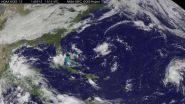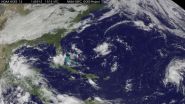(Press-News.org) VIDEO:
This GOES-East satellite image animation of Edouard from Sept. 13 through 15 showed the storm consolidating. The eye of the hurricane became visible on and off during Sept. 14 in...
Click here for more information.
NASA's Terra satellite passed over Tropical Storm Edouard each day from September 12 through 14 and captured imagery of the storm as it grew into a hurricane. NOAA's GOES-East satellite covers the Atlantic Ocean and takes visible images during the day and infrared images at night to show the movement of weather systems. Those images were compiled into a movie from Sept. 13 through 15 showing movement and intensification of Edouard into a hurricane. NASA's HS3 Mission also investigated the storm.
NASA's Terra satellite captured the three images of Edouard as it transitioned into a hurricane. When Terra flew over the storm, the Moderate Resolution Imaging Spectroradiometer (MODIS) instrument captured visible images on September 12 at 9:10 a.m. EDT, September 13 at 9:50 a.m. EDT, and September 14 at 10:35 a.m. EDT. The three images together show that Edouard consolidated as it strengthened - that is, bands of thunderstorms became more tightly wrapped around the storm. By September 14, the bands of thunderstorms were concentrated over the northern quadrant of the storm and wrapping into the cloud-filled eye.
The NASA/NOAA GOES Project at NASA's Goddard Space Flight Center in Greenbelt, Maryland combined NOAA's GOES-East satellite imagery of Edouard taken over several days from September 13 through 15. The showed the storm consolidating. The eye of the hurricane became visible on and off during September 14 in between being obscured by high clouds, and the eye opened again on September 15.
On Sunday morning, September 14, 2014 at 1102 UTC (7:02 a.m. EDT) NASA's Global Hawk 872 took off from NASA's Wallops Flight Facility, Virginia on a flight toward Tropical Storm Edouard for a 24 hour mission. It was the sixth science flight for the Global Hawk during the Hurricane and Severe Storms Sentinel or HS3 mission. For more information about NASA's HS3 mission, visit: http://www.nasa.gov/hs3
On Sunday at 5 p.m. EDT Edouard's maximum sustained winds had increased to near 85 mph (140 mph) and additional strengthening is forecast. The National Hurricane Center (NHC) noted on Monday, September 15 at 11 a.m. EDT that Edouard's maximum sustained winds increased to 105 mph (165 kph) making it a Category 2 hurricane on the Saffir-Simpson Scale.
NHC forecaster Cangliaosi noted "Satellite images show that the eye of Edouard has become larger and more distinct during the past few hours, with a fairly symmetric inner-core convective pattern."
The center of Hurricane Edouard was near latitude 27.3 north and longitude 55.5 west. That's about 655 miles (1,055 km) east-southeast of Bermuda. Edouard was moving toward the northwest near 14 mph (22 kph) and a movement toward the north is expected on Tuesday, September 16. The estimated minimum central pressure is 966 millibars.
The NHC forecast calls for some strengthening through the end of the day on September 16 while the hurricane remains in favorable conditions. Beyond that time, cooler water, dry air, and a pronounced increase in wind shear is expected to cause Edouard to weaken steadily.
INFORMATION:
Rob Gutro
NASA's Goddard Space Flight Center
Satellites show Edouard's transition into an Atlantic Hurricane
2014-09-15
ELSE PRESS RELEASES FROM THIS DATE:
NASA sees Typhoon Kalmaegi as a whirlpool of clouds in the South China Sea
2014-09-15
NASA's Aqua satellite observed Typhoon Kalmaegi crossing the South China Sea and a satellite image from the MODIS instrument aboard made it look like a whirlpool of clouds.
On Sunday, September 14, Kalmaegi passed over northern Luzon, Philippines and emerged into the South China Sea. Typhoon Kalmaegi's maximum sustained winds were near 65 knots (75 mph) making it a category one hurricane on the Saffir-Simpson scale as it moved over the Philippines.
On September 15 at 05:15 UTC (1:15 a.m. EDT) the Moderate Resolution Imaging Spectroradiometer aboard NASA's Aqua satellite ...
Number-crunching could lead to unethical choices, says new study
2014-09-15
Toronto – Calculating the pros and cons of a potential decision is a way of decision-making. But repeated engagement with numbers-focused calculations, especially those involving money, can have unintended negative consequences, including social and moral transgressions, says new study co-authored by a professor at the University of Toronto's Rotman School of Management.
Based on several experiments, researchers concluded that people in a "calculative mindset" as a result of number-crunching are more likely to analyze non-numerical problems mathematically and not take ...
Researchers develop improved means of detecting mismatched DNA
2014-09-15
Researchers at Johns Hopkins have identified a highly sensitive means of analyzing very tiny amounts of DNA. The discovery, they say, could increase the ability of forensic scientists to match genetic material in some criminal investigations. It could also prevent the need for a painful, invasive test given to transplant patients at risk of rejecting their donor organs and replace it with a blood test that reveals traces of donor DNA.
In a report in the September issue of The Journal of Molecular Diagnostics, the research team says laboratory tests already show that ...
Freshman girls know how to eat healthy but lack confidence in their ability to do it
2014-09-15
URBANA, Ill. – Female college freshmen understand the benefits of eating healthy foods and know which foods they should include in their diets. But they lack confidence in their ability to act on that knowledge, especially when it comes to getting enough calcium, says a new University of Illinois study.
"The women in our study weren't very confident about their ability to eat a healthful diet, especially if they had to do something physical like chop vegetables or go shopping. The motivation just wasn't strong if they were at a party or in places where there were other ...
Study: Web-based training can reduce campus rape
2014-09-15
Web-based training targeted at college-aged men is an effective tool for reducing the number of sexual assaults on U.S. campuses, according to a researcher in the School of Public Health at Georgia State University.
The RealConsent program reduced sexually violent behavior and increased the likelihood a male student would intervene to prevent a sexual assault, said Dr. Laura Salazar, associate professor of health promotion and behavior, who published the findings in the paper, "A Web-Based Sexual Violence Bystander Intervention for Male College Students: Randomized Controlled ...
Study indicates hunting restrictions for tapirs may not be enough
2014-09-15
A published study indicates that lowland tapir populations may continue to drop in French Guiana, despite recent restrictions on hunting. Researchers from the Office National de la Chasse et de la Faune Sauvage in French Guiana and San Diego Zoo Global reviewed data retrieved from camera traps in the Nouragues National Reserve over the last four years and compared this data to current harvest rates in the region.
"In 2011, restrictions were placed on hunting tapirs in French Guiana," said Matthias Tobler, a scientist with the San Diego Zoo Institute for Conservation Research. ...
Northeastern University Researchers Develop Novel Method for Working with Nanotubes
2014-09-15
An interdisciplinary team of researchers led by Northeastern University has developed a novel method for controllably constructing precise inter-nanotube junctions and a variety of nanocarbon structures in carbon nanotube arrays. The method is facile and easily scalable, which will allow the researchers to tailor the physical properties of nanotube networks for use in applications ranging from electronic devices to CNT-reinforced composite materials found in everything from cars to sports equipment.
Their findings were published in the journal Nature Communications in ...
iPhone Chemistry: Elements of a smartphone
2014-09-15
WASHINGTON, Sept. 15, 2014 — By now, we've got all the details about Apple's latest iPhone, and the lines are probably forming somewhere for the Sept. 19 launch. But what do you really know about the guts of the iPhone 6, or any smartphone for that matter? Reactions teamed up once again with the Compound Interest blog to reveal the chemical elements found inside your smartphone. Learn all about it at http://youtu.be/66SGcBAs04w.
INFORMATION:
Subscribe to the series at Reactions YouTube, and follow us on Twitter @ACSreactions to be the first to see our latest videos. ...
Oregon researchers urge psychologists to see institutional betrayal
2014-09-15
EUGENE, Ore. -- Clinical psychologists are being urged by two University of Oregon researchers to recognize the experiences of institutional betrayal so they can better treat their patients and respond in ways that help avoid or repair damaged trust when it occurs in their own institutions.
The call to action for clinicians as well as researchers appears in a paper in the September issue of the American Psychologist, the leading journal of the American Psychological Association.
In their paper, UO doctoral student Carly P. Smith and psychology professor Jennifer J. ...
When rulers can't understand the ruled
2014-09-15
Johns Hopkins University political scientists wanted to know if America's unelected officials have enough in common with the people they govern to understand them.
The answer: Not really.
Surveying 850 people who either work in the federal government or directly with it, researchers found that the inside-the-Beltway crowd has very little in common with America at large. Washington insiders are more likely to be white. They are more educated. Their salaries are higher, they vote more often and they have more faith in the fairness of elections. They are probably Democrat ...






